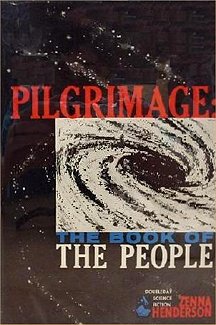

Teleportation in Science Fiction
|
|
Teleportation, a hypothetical method of transportation in which matter or information is dematerialized, usually instantaneously, at one point and recreated at another, is one of a number of superhuman mental abilities commonly grouped under the heading of "psionics," a term coined by SF editor John W. Campbell in the 1950's to impart a scientific patina to that which had previously been viewed as magic or occult powers. |

|
This in itself represents an interesting sub-theme within SF - stories in which some supernatural
element is given a rational, scientific basis in fact. Excellent examples include
Richard Matheson's I Am Legend (in which vampirism results from a viral infection) and
Clifford Simak's Goblin Reservation (which, coincidentally, prominently features a technology-based teleportation system as part of the plot).
The "pure" form of mental-based teleportation is often perceived to be an expression of
adolescent wish fulfillment. A Google search on "What superpower" brings up numerous
forum discussions about which superpower would be the best to have. Though invisibility and flying are most frequently brought to the table, still, many vote for ESP, psycho kinesis, "time-stopping" and, of course, teleportation. Ira Glass's radio show,
This American Life, devoted an entire episode (see episode 178, 2/23/2001) to this topic.
When asked to what end they would use their superpowers, most participants responded with examples
that would ordinarily be classified as stereotypical adolescent behavior: playing practical jokes,
avoiding standing in lines, voyeurism, showing off for girls
(usually referred to as "chicks"), getting rich, stealing, getting even with enemies or
spying on friends. John Hodgman of This American Life notes that not one person he surveyed said they would fight crime with their superpower.
Thus, it is no surprise that many of the heroes of SF/fantasy teleportation stories are teenagers - or at least are characters that isolated, confused, angst-ridden teens can easily identify with. Probably the best example of this link between adolescent wish fulfillment fantasy and super powers are Zenna Henderson's stories about The People - human-like aliens who attempt to settle unnoticed on Earth after their home planet is destroyed.
The People are gifted with a variety of psionic powers including telepathy, telekinesis,
and the ability to fly, and some develop very specialized abilities like dowsing (for water,
metal ore, etc.) or precognition. Henderson's gentle stories quite frequently focus on
troubled young people and the rare adults who take the trouble to understand and help them.
Collections include Pilgrimage: The Book of the People
(New York: Doubleday and Co. 1961; $125+), The People: No Different Flesh
(London: Victor Gollancz, 1966; $250+ and New York: Doubleday and Co. 1967; $125+), and
Ingathering: The Complete People Stories (Framingham, MA: The Nesfa Press, 1995; combines the two previous collections plus some unpublished stories; $25+).
What is striking about the most popular choices for putting superpowers to use is that they
reduce to a very small number of primal drives: sex, survival and competition, play - and revenge.
Alfred Bester's The Stars My Destination, originally published as Tiger! Tiger!, London: Sidgwick & Jackson, 1956; $1000+ (first US hardback, Boston: Gregg Press, 1975; $500+, no dust jacket issued), a true SF classic, is, at its heart, a story of revenge. Abandoned to near-certain death after his ship is wrecked in deep space, miraculously rescued but then wrongfully imprisoned, Gully Foyle seeks revenge. Foyle is described in his psychological profile as a stereotypical Common Man who has reached a dead end in life, but he experiences things that shock him into an awakening. He escapes from prison and, with the burning motivation of revenge driving him on, becomes a rich and powerful man. In Foyle's 24th century world, the ability to teleport at will, or jaunt, is a power available to the rich, and the impact that jaunting has on the culture is exceptionally well developed.
Foyle's odyssey of revenge has often been compared to that of Edmond Dantes in
The Count of Monte Cristo. While many strong parallels do exist, differences in the central
characters are notable. Dantes begins as a young man of prospects, hard working and honest to a
fault, while Foyle is a coarse and violent character with no motivation and less conscience. Of
course, Dumas' Count of Monte Cristo is the go-to book when talking about stories of
revenge, just as any book that dramatizes extravagantly self-destructive rich people will inevitably
be compared to The Great Gatsby.
Questions or comments?
| Forum
| Store
| Publications
| BookLinks
| BookSearch
| BookTopics
| Archives
| Advertise
| AboutUs
| ContactUs
| Search Site
| Site Map
| Google Site Map
Store - Specials
| BookHunt
| BookShelf
| Gold Edition & BookThink's Quarterly Market Report
| DomainsForSale
| BookThinker newsletter - free
Copyright 2003-2011 by BookThink LLC

Contact the editor, Craig Stark
editor@bookthink.com
